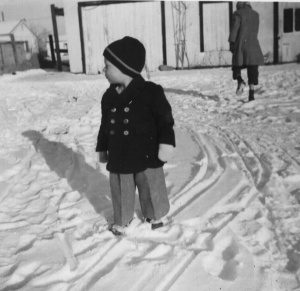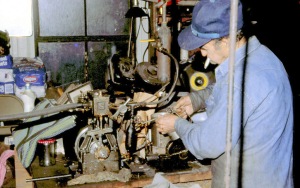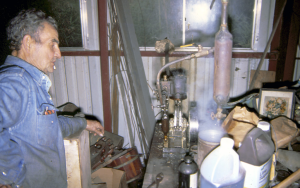Ever see a ghost? I did. Not only saw it, but came back and visited with my camera and have the pictures to prove it.
From just after my birth until I was about 3, we lived in a garage apartment that was between E. 32nd and 33rd streets on Pecan in Texarkana.
The place was owned by a family named the Acostas. Their son lived with them at the time in a house that adjoin the Pecan property on Hickory street, and while I do not know if I ever knew his real name, we knew him as “Blackie.” That’s because even at that time he was a fully qualified blacksmith. I want to ensure you know what that means, as many confuse blacksmith with someone who fits horseshoes to horses. That’s a “farrier” and not at all the same thing. A real blacksmith would actually make a horseshoe from a junk of shapeless metal…or a Bowie knife…or a steam engine. I’ve not researched extensively, but there are probably no more than a 100 or so truly fully qualified blacksmiths left in the United States today. I do not know from whom he learned this ancient skill, but Blackie was a master who could turn out an Excalibur or a piston for a marine steam engine that was both a piece of technology and a work of art.
Of course, at age 3 and toddling I really wasn’t quite fully able to appreciate these things, but I was already showing signs of the rather strange interests I maintain to this day. I had told my family of a memory for years, and while they all knew who I was speaking of, nobody remembered the steam engine at all and uniformly felt I had sort of dreamed it or something. However, they remembered the box kite.
The box kite was very large. I could stand inside it easily and to me it was really, really big. It was, in fact, big enough that Blackie had spooled some clothesline wire onto a tractor wench they had in the garden to fly it as I presume he felt it was going to have serious lift. Now, I hate to disappoint, but I have no memories of it flying. Just lying behind the tractor connected by wire to the wench.
My brother remembered that, but nobody remembered the steam engine. My memory was quite clear, but mainly a very small time snippet. At 3, I was, of course, pretty short. So the memory was being in a shop building and looking up at this little machine chuffing away, dripping with fragrant oil, and steam rising up into the room. No more.
1985. I’ve just signed a contract to develop the Centre for Educational Technology at the National University of Singapore and am visiting my mother. While it was only for three years, going abroad has this feeling associated with it of needing to connect as though one were wrapping up one’s earthly affairs. So I drove past all the old places of my youth. The apartment was still standing, though worse for wear and tear. I stopped on the side of the street and suddenly noticed a man walking behind an ancient gasoline rototiller, an old plowing device for small areas that had a front end that looked like a miniature tractor but you walked behind. He was wearing a train engineer-type cap and classic striped coveralls complete with suspenders. A ghost.
My brain registered this as “Blackie” at once, but the “here and now” part of it clearly repeated “That does not compute.” I’ve since come to believe that the younger one is, the more they see “adults,” regardless of how young they may be, as they will be when they are much older. It was the only way I could explain to myself at that moment why I was seeing a person as they were in 1953 in the year 1985. Nonetheless, the “here and now” kept telling me this is not Blackie, but his son or someone who just looked like him. However, I got out of the car and walked to the fence and called out “Blackie?” He looked up, stopped the engine, and said “Yes sir?”
It was Blackie in the flesh, and looking precisely as I remembered him right down to the Prince Albert hand-rolled cigarette stub in his mouth. He remembered my family well and after a few minutes of talk I related my memory of the steam engine.
“Oh, yes, the Stewart…” he said, “wanna see it?” We set up a time for the next day, as I wanted all the time I could get.
I returned the next day armed with 200ASA Ektachrome and my old Yashica camera from my Army days. We went off straightway to the shop, and there it was, almost certainly precisely where it was when I first gazed up at it in wonder and fascination 3 decades before. He explained that it was a model of a 19th century British Stewart industrial steam engine. The original would have been huge, probably 40 feet or so high and run an entire line. He had fabricated virtually every piece of it from raw iron and steel. That’s what a blacksmith did. I said “Wish I could see it run.” My wish was Blackie’s command and it was if he’d been waiting for somebody to throw him in that briar patch for years. We headed out back of the shop and there stood the same boiler he’d run that day so long ago with a wide eyed toddler looking on. He filled it until the sight glass was right, loaded up the fuel and tender, and set the fire. As we waited for pressure to build, he explained about fire and water tube boilers, and that this particular one…which, of course, he’d built…was a low pressure water tube marine boiler. By the time he’d explained the nuances of boiler technology, we had the 40 lbs of pressure needed. He opened the live steam line to the shop and we trooped back in. Blackie pick up an oil can and squirted oil in a number of places on the little Stewart, then opened the valve. It chuffed into life immediately and slung oil in all directions. The smell of hot oil and steam permeated the room. Blackie leaned over and squirted even more, then looked towards me and pronounced in a grave voice “Steam engines. They’re greasy and smelly, and I like’em!”
Blackie showed me some pieces he’d fabricated for an order he’d received from someone in Louisiana for a 2.5 horsepower marine steam engine. That may not sound like much horsepower, but it’s about the same as that one you may have seen in the classic Bogart/Hepburn film “The African Queen.” The pieces were beautiful and crafted from raw metal by the blacksmith’s art, then machined in Blackie’s shop to perfect tolerance. That engine is probably in service somewhere in the bayous or Gulf waters today will serve reliably for a 100 years if maintained properly.
Blackie also showed me his raw steel billets for knife making. Swords and knives have been, of course, the blacksmith’s highest order of workmanship for thousands of years. He explained that his steel was real Damascus steel, made by Arab wanderers over charcoal fires in the desolate spaces in Syria. Syria was, at that time, closed, but he had long-standing connections that smuggled this steel to him. He showed me a finished knife, a classic chef’s knife. Attempting to describe the perfect feel of this knife and its scalpel-sharp edge in words is like trying to tell somebody what the “Moonlight Sonata” sounds like played on a Steinway by Rubenstein, so I will leave it at “Wondrous work of art.” I asked what he’d charge to make one, and he said “55.00.” I was stunned. I remain stunned that I didn’t order one on the spot and have it to hand down to my son, and his son. However, I guess I thought we’d have time for that later and there was still so much to see and hear.
Finally, we went back outside and he fired up his forge and demonstrated overlay welds using scrap. This was how he’d make a chef’s knife. He started with a single billet of already fine Damascus steel. This was about 4 feet long, a couple of inches wide, and perhaps 3/8ths inch thick. He heated in the forge until his eyes told him it was precisely right, and would then bend the end over a few inches from the end and hammer it into the next section. This would require several re-heatings and hammering out before bending another section over and repeating the process. As the process went on, impurities were beaten from the steel and flew away in explosive sparks. Of course, the sound of the big blacksmith’s hammer was wonderful as it struck the work piece and the anvil. When an entire billet had been laid over hundreds of times and hammered into itself, you had about an 11” piece of world-class knife blade to be. Made in America to last a lifetime!
It was during one of his incredibly powerful down strokes I saw him wince, pale a bit, and say “It’s getting harder than it used to be.” All too soon, I would find out why.
Blackie invited me to his house for a rest and we sat in his kitchen. I am not sure there was anywhere else in his house one could have sat, as I could see into what was likely once a dining room a dark, narrow path between ceiling high stacks of, well, stuff. I suspect the entire house was that way. He’d lived there all his life and never married, as best I can tell. I suspect he at an awful lot of money somewhere, as he told me how he was a heavy lift engineer and had, in the not too distant past, been in the north sea supervising massive multi-thousand ton lifts of offshore platform for Royal Dutch Shell. Apparently, Blackie was their “go to guy” for such specialized work. I don’t think it unreasonable to assume that he was underpaid for this. But, of course, Blackie had no use for money. He probably only did the work because he found it fun.
I left Blackie that afternoon looking forward to returning to visit with him more, and have him make one of those knives for me. I was sitting at my desk at the National University of Singapore about six months later when I opened a letter from my mother and a newspaper clipping fell out. It was Blackie’s obituary. He’d died of lung cancer, probably undiagnosed and advanced when I visited him. I was deeply saddened, but grateful that God had given me that time to honor an unknown master craftsman and for him to know someone had noticed and remembered his art and passion and sought him out. I do not think Blackie had any living relatives, so it is quite possible that all these wondrous products of his hands were sold at auction. New homes now stand where all this took place and no sign remains of anything I’ve described here. I only hope at least someone had a clue as to the priceless value of the works of his hands.
“Blackie” Acosta peering back into the Age of Steam. I do not know where Blackie is today, but I am sure of one thing: If it ain’t smelly and greasy, he don’t like it!




